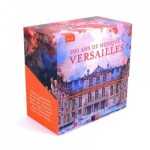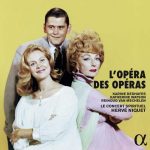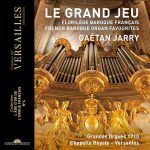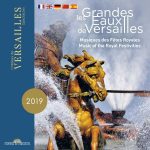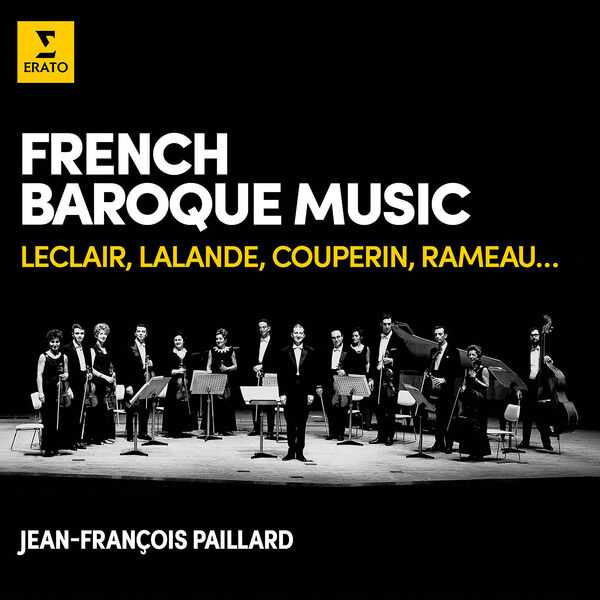
Format: FLAC (tracks)
Label: Erato
Catalogue: 9029628784
Release: 2022
Size: 14.9 GB
Recovery: +3%
Scan: cover
Leclair: Violin concerto Op. 7, No. 1
01. I. Allegro
02. II. Aria
03. III. Vivace
Leclair: Violin Concerto in D Major, Op. 7 No. 2
04. I. Adagio – Allegro ma non troppo
05. II. Adagio
06. III. Allegro
Leclair: Flute Concerto Op. 7 No. 3 in C major
07. I. Allegro
08. II. Adagio
09. III. Allegro assai
Leclair: Violin Concerto Op. 7 No. 4 in F major
10. I. Allegro moderato
11. II. Adagio
12. III. Allegro
Leclair: Concerto Op. 7 No. 5 in A minor
13. I. Vivace
14. II. Largo
15. III. Allegro assai
Leclair: Violin Concerto in A Major, Op. 7 No. 6
16. I. Allegro ma non troppo
17. II. Aria. Grazioso
18. III. Giga. Allegro
Leclair: Concerto Op. 10 No. 1 in B flat major
19. I. Allegro
20. II. Andante
21. III. Giga. Allegro ma non troppo
Leclair: Violin Concerto in A Major, Op. 10 No. 2
22. I. Allegro ma non troppo
23. II. Adagio
24. III. Allegro ma non troppo
Leclair: Violin Concerto in D Major, Op. 10 No. 3
25. I. Allegro moderato
26. II. Andante
27. III. Allegro ma non troppo
Leclair: Violin Concerto in F Major, Op. 10 No. 4
28. I. Allegro ma poco
29. II. Aria. Grazioso, andante
30. III. Allegro
Leclair: Violin Concerto in E Minor, Op. 10 No. 5
31. I. Allegro ma poco
32. II. Largo
33. III. Allegro
Leclair: Violin Concerto in G Minor, Op. 10 No. 6
34. I. Allegro ma non troppo
35. II. Aria. Grazioso
36. III. Allegro
Corrette: Flute Concerto in E Minor, Op. 4 No. 6
37. I. Allegro
38. II. Largo
39. III. Allegro
Blavet: Flute Concerto in A minor
40. I. Allegro
41. II. Gavottes I & II
42. III. Allegro
Naudot: Flute Concerto in C Major, Op. 17 No. 3
43. I. Gaiement
44. II. Lentement
45. III. Légèrement
Couperin: Les Nations: Premier Ordre ‘La Françoise’
46. I. Sonade
47. II. Allemande
48. III. Première courante
49. IV. Seconde courante
50. V. Sarabande
51. VI. Gigue
52. VII. Chaconne ou Passacaille
53. VIII. Gavotte
54. IX. Menuet
Couperin: Les Nations: Deuxième Ordre ‘L’Espagnole’
55. I. Sonade
56. II. Allemande
57. III. Courante
58. IV. Seconde courante
59. V. Sarabande
60. VI. Gigue lourée
61. VII. Gavotte
62. VIII. Rondeau
63. IX. Bourée
64. X. Double de la bourée précédente
65. XI. Passacaille
Couperin: Les Nations, Troisième ordre ‘L’Impériale’
66. I. Sonade
67. II. Allemande
68. III. Courante
69. IV. Seconde courante
70. V. Sarabande
71. VI. Bourée
72. VII. Gigue
73. VIII. Rondeau
74. IX. Chaconne
75. X. Menuet
Couperin: Les nations, Quatrième ordre ‘La piémontoise’
76. I. Sonade
77. II. Allemande
78. III. Courante
79. IV. Seconde courante
80. V. Sarabande
81. VI. Rondeau
82. VII. Gigue
Couperin: Les goûts-réünis, Grande sonate “Le Parnasse ou L’apothéose de Corelli”
83. I. Corelli au pied du Parnasse prie les Muses de le recevoir parmi elles
84. II. Corelli, charmé de la bonne réception qu’on lui fait, marque sa joye
85. III. Corelli buvant à la source d’Hypocrène
86. IV. Enthouziasme de Corelli causé par les eaux d’Hypocrène
87. V. Corelli après son enthouziasme s’endort
88. VI. Les Muses réveillent Corelli et le placent auprès d’Apollon
89. VII. Remerciement de Corelli
Aubert: Concerto à 4 violons en sol mineur, Op. 17 No. 6
90. I. Allegro
91. II. Aria grazioso
92. III. Allegro
Dauvergne: Troisième concert de simphonies à 4 parties en si mineur, Op. 4 No. 1
93. I. Ouverture. Grave – Presto
94. II. Aria gratioso I & II
95. III. Allegro I & II
96. IV. Passacaille
Charpentier: Sonate à 8, H. 548
97. I. Grave (Arr. Paillard)
98. II. Récit de la viole seule (Arr. Paillard)
99. III. Sarabande (Arr. Paillard)
100. IV. Récit de la basse de violon (Arr. Paillard)
101. V. Bourrée (Arr. Paillard)
102. VI. Gavotte (Arr. Paillard)
103. VII. Gigue (Arr. Paillard)
104. VIII. Passacaille (Arr. Paillard)
105. IX. Chaconne (Arr. Paillard)
106. Charpentier: In nativitatem Domini canticum, H. 416: Nuit (Arr. Lambert)
Couperin: Apothéose de Lully
107. Lulli aux Champs Elisés, concertant avec les Ombres liríques (Gravement) [Arr. Paillard]
108. Air pour les mêmes (Gracieusement) [Arr. Paillard]
109. Vol de Mercure aux Champs Elisés, pour avertir qu’Apollon y va descendre (Tres viste) [Arr. Paillard]
110. Descente D’Apollon qui vient offrir son violon à Lulli, et sa place au Parnasse (Noblement) [Arr. Paillard]
111. Rumeur souteraine causée par les auteurs contemporains de Lulli (Viste) [Arr. Paillard]
112. Plaintes des Mêmes par des flûtes ou des violons très adoucis (Dolemment) [Arr. Paillard]
113. Enlèvement de Lulli au Parnasse (Très légèrement) [Arr. Paillard]
114. Accueil, entre doux et agard, fait à Lulli par Corelli et par les muses Italiénes (Largo) [Arr. Paillard]
115. Remerciment de Lulli à Apollon (Gracieusement) [Arr. Paillard]
116. Lulli et les muses Françoises, Corelli et les muses Italiénes (Elégamment, sans lenteur – Doux et modérément) [Arr. Paillard]
117. Lulli joüant le Sujet, et Corelli l’acompagnant (Air léger pour deux violons) [Arr. Paillard]
118. Corelli joüant le Sujet à son tour, que Lulli acompagne (Second air) [Arr. Paillard]
119. Sonade en trio. Gravement
120. Saillie: I. Vivement
121. Saillie: II. Rondement
122. Saillie: III. Vivement
Rameau: Premier Concert transcrit en sextuor
123. I. La Coulicam
124. II. La Livri
125. III. Le Vézinet
Rameau: Deuxième Concert transcrit en sextuor
126. I. La Laborde
127. II. La Boucon
128. III. L’agaçante
129. IV. Menuets I & II
Rameau: Troisième Concert transcrit en sextuor
130. I. La Poplinière
131. II. La Timide
132. III. Tambourins I & II
Rameau: Quatrième Concert transcrit en sextuor
133. I. La pantomime
134. II. L’indiscrète
135. III. La Rameau
Rameau: Cinquième Concert transcrit en sextuor
136. I. La Forqueray
137. II. La Cupis
138. III. La Marais
Rameau: Sixième Concert transcrit en sextuor
139. I. La poule
140. II. Menuets I & II
141. III. L’enharmonique
142. IV. L’égyptienne
Rameau: Hippolyte et Aricie, Act 4
143. Chœur. “Faisons partout voler nos traits”
144. Premier air. “Amants, quelle est votre faiblesse ?”
145. Deuxième air en rondeau. “Courons tous à la chasse”
146. Menuets
Mouret: Symphonies de chasse
147. I. Fanfare et Air
148. II. Airs, gracieusement
149. III. Gavottes
150. IV. Menuets
Corrette: Concerto comique No. 14 pour cors, “La Choisy”
151. I. Allegro
152. II. Adagio
153. III. Allegro
Lalande: Concert de trompettes pour les festes sur le canal de Versailles
154. I. Premier air
155. II. Deuxième air
156. III. Troisième air (Chaconne en écho)
157. IV. Premier menuet – Deuxième menuet, trio de hautbois
158. V. Air en écho, fanfare
Lalande: Premier Caprice ou Caprice de Villers-Cotterets
159. I. Fièrement et détaché
160. II. Augmentation, premier air neuf
161. III. Trio – Augmentation, deuxième air neuf
162. IV. Suitte de l’ancien
Lalande: Deuxième Caprice ou Caprice que le Roy demandoit souvent
163. I. Un peu lent – Vite – Doucement
164. II. Gracieusement – Gayement – Vivement
Lalande: Troisième Caprice
165. I. Premier air. Gracieusement
166. II. Deuxième air mineur
167. III. Troisième air. Presto
168. IV. Quatrième air – Gigue. Gracieusement
169. V. Cinquième air – Quatuor et Prélude
170. VI. Sixième air. Vif
Francoeur: Simphonie du festin royal de Monseigneur le comte d’Artois, Quatrième suite
171. I. Menuets I & II (D’après Rebel)
172. II. Entrée des chasseurs (D’après Dauvergne)
173. III. Menuet gracieux (D’après Rameau)
174. IV. Air tendre
175. V. Air en rondeau
176. VI. Musette (D’après de Mondonville)
177. VII. Rondeau (D’après de Mondonville)
178. VIII. Rondeaux
179. IX. Rondeau gay
Francoeur: Simphonie du festin royal de Monseigneur le comte d’Artois, Deuxième suite
180. I. Ouverture
181. II. Air majestueux (D’après Rameau)
182. III. Contredanse
183. IV. Air gracieux
184. V Air vif
185. VI. Gavottes
186. VII. Air très vif (D’après Dauvergne)
187. VIII. Air marqué
188. IX. Air en chaconne (D’après de Bury)
189. X. Gavottes (D’après de Mondonville)
190. XI. Air vif
191. XII. Gavotte (D’après Rameau)
Mouret: Fanfares pour des trompettes, timbales, violons et hautbois
192. I. —
193. II. Gracieusement, sans lenteur
194. III. —
195. IV. Guay
Mouret: Simphonies pour des violons, des hautbois et des cors de chasse
196. I. Prélude
197. II. Allegro
198. III. Air, Gracieusement
199. IV. Gavottes
200. V. Fanfare et air
201. VI. Menuets
202. VII. Allegro
Lully: Amadis, LWV 63, Prologue
203.Ouverture
204.Premier air
205.Second air. Gigue
206. Rondeau. Les suivants d’Alquif et d’Urgante
Lully: Amadis, LWV 63, Act 2
207. Air pour les démons et les monstres
Lully: Amadis, LWV 63, Act 4
208. Menuet pour les suivantes d’Urgante
Lully: Amadis, LWV 63, Act 1
209. Premier air des combattants
210. Second air
211. Marche pour le combat de la barrière
anon.: Suite française en sol mineur
212. I. Ouverture
213. II. Bourrée
214. III. Sarabande
215. IV. Prélude
216. V. Concert
217. VI. Gigue
Exaudet: Trio Sonata in G Major, Op. 2 No. 1
218. III. Minuetto gracioso (Arr. Paillard)
Lully: Le bourgeois gentilhomme, LWV 43, Act II, Scene 1
219. Menuet
Lully: Les airs de trompettes, timbales et hautbois fait par M. de Lully par l’ordre du Roy pour le carouzel de Monseigneur, LWV 72
220. Prélude – Menuet – Gigue
221. Corrette: Divertissement pour deux trompettes, Op. 7
222. Philidor: Gavotte des Festins
223. Philidor: Les Echos de Jupiter
224. Philidor: La marche des dragons du Roy
225. Dampierre: Quatrième fanfare
226. Dampierre: Onzième fanfare
227. Lully: Marche De Savoye
228. Philidor: Canon de Versaille à cinq parties
229. Philidor: Marche pour les trompettes
Lully: Marche du Régiment du Roy
230. Air des hautbois (An 1670)
231. Air des hautbois – Les folies d’Espagne (An 1702)
32. Dampierre: Fanfare – Gavotte, Spiritoso
233. Dampierre: Première fanfare – Allegro
Lully: La marche française
234. Air de la marche française pour les hautbois
235. Air ensuite
236. Molière: Air de Mr de Molière de la Musique du Roy
237. Lully: Air De Mr de Lully
238. Philidor: Marche royalle à trois dessus de hautbois pour la Marche Française (An 1769)
239. Dampierre: Douzième fanfare
240. Dampierre: Deuxième fanfare
241. Lully: Marche des fusilliez – Air for oboes
242. Philidor: La bontemps
243. Philidor: Mars
244. Philidor: Marche à quatre timbales
245. Dampierre: Fanfare – Affettuoso
246. Dampierre: Troizième fanfare
Lully: Marche des Mousquetaires
247. I. Air des hautbois
248. II. Air ensuite par le mesme
249. III. Air ensuite par le mesme
250. IV. Air par le mesme, Philidor L’Aîné en ayant fait les parties, Mr de Lully ne les ayant pas voulu faire
251. V. Air par le mesme
252. VI. Air par le mesme
253. Philidor: Menuet royal
254. Philidor: Marche Hollandaise
255. Philidor: Menuet de l’Orangerie
256. Philidor: Gigue Des Arts
Courbois: Cantate française No. 7 “Don Quichotte”
257. Prélude – Récitatif. “Don Quichotte enfoncé dans la montagne noire” – Air. “Loin des yeux”
258. Récitatif. “Signalons sur ces monts” – Air. “Vous qui travaillez à ma gloire”
259. Récitatif. “Le fameux chevalier” – Air. “Mordi, faut-il pour ingrate”
Boismortier: Cantates françoises, Op. 5 “Les quatre saisons”, No. 3, L’automne
260. Air. “Où suis-je”
261. Récitatif. “Mais profitons des beaux jours de l’Automne” – Air. “Coule, coule dans nos veines”
262. Récitatif. “Quel est donc de naissance” – Air. “En vain la plus fière beauté”
263. Air. “C’est en fait, par Bacchus”
Campra: Premier livre de cantates françoises, No. 6, Les femmes
264. Air. “Dans un désert inaccessible” – Air. “Par les vents et par l’orage”
265. Air. “Ah, qu’un coeur est malheureux”
266. Air. “La coquette nous trahit”
267. Air. “Fils de la nuit”
268. Air. “Je borne mes rêveries”
269. Récitatif. “Que les amants dans leurs chaînes”
Rameau: Thétis
270. Ouverture-Récitatif. “Muse, dans vos divins concerts” – Air. “Volez tyrans”
271. Récitatif. “Neptune en ce moment” – Air. “Partez, volez, brillants éclairs”
272. Récitatif. “Quel aveugle transport vous guide” – Air. “Beauté qu’un seul destine”
Leclair: Trio Sonata in D Minor, Op. 4 No. 3
273. I. Adagio
274. II. Fugue. Allegro
275. III. Aria. Allegro ma poco
276 .IV. Sarabande. Largo
277. V. Allegro
Boismortier: Concerto in Five Parts in E Minor, Op. 37 No. 6
278. I. Allegro
279. II. Adagio
280. III. Allegro
Naudot: Oboe Concerto in C Major, Op. 17 No. 3
281. I. Gaîment
282. II. Lentement
283. III. Légèrement
Leclair: Oboe Concerto in C Major, Op. 7 No. 3
284. I. Allegro
285. II. Adagio
286. III. Allegro assai
Buffardin: Flute Concerto in E Minor
287. I. Allegro con moto (Arr. Paillard)
288. Rameau: Pygmalion: Ouverture
Lalande: Simphonies pour le souper du Roy, Suite No. 4
289. Symphonie du Te Deum
290. Air du ballet de Cardenio
291. Air de la première suite
292. Sarabande de Cardenio
293. Musette du ballet de l’Inconnu
294. Air de fanfare en écho
295. La pagode
296. Rondo du ballet de Cardenio
297. Air du concert de trompettes “Pour les festes sur le canal de Versailles”
298. Chaconne en écho avec les trompettes
Marais: Suite d’Alcyone
299. Ouverture à la françoise
300. Marche pour les bergers et les bergères
301. Bourrée pour les bergers et les bergères
302. Passepieds I & II pour les mêmes
303. Marche pour les matelots
304. Deuxième air des matelots
305. Troisième air des matelots
306. Symphonie pour le sommeil
307. Menuet entr’acte
308. Tempeste
Charpentier: Noël sur les instruments, H. 534
309. I. Les bourgeois de Châtres
310. III. Joseph est bien marié
311. IV. Or dites-nous Marie
312. II. Où s’en vont ces gays bergers
Charpentier: Noël sur les instruments, H. 531
313. I. Ô Créateur
Charpentier, M-A: Noël sur les instruments, H. 534
314. V. À la venue de Noël
paillard-french-baroque-music-leclair-lalande-couperin-rameau02.rar – 3.4 GB
paillard-french-baroque-music-leclair-lalande-couperin-rameau03.rar – 2.5 GB
paillard-french-baroque-music-leclair-lalande-couperin-rameau04.rar – 3.3 GB
paillard-french-baroque-music-leclair-lalande-couperin-rameau05.rar – 3.0 GB
A founding member of Erato, Jean-François Paillard always placed French Baroque music at the heart of his orchestra’s repertoire and maintained it in a privileged position despite the growth of musical range and number of concerts. Originally named Ensemble Instrumental Jean-Marie Leclair, it has never ceased to highlight the concertos of this immense violinist alongside the works by Couperin, Rameau and a number of other composers remained in the shadows. These are all opportunities for the orchestra to shine, together with young soloists such as M. André, J.P. Rampal or G. Souzay.
The raison d’être (to employ a singularly appropriate term) of this set was to collect the Erato label recordings made as the result of an enterprise launched seventy years ago when conductor Jean-François Paillard (1928-2013) established his Ensemble Instrumental “to revive by means of both its make-up and its repertoire the letter and spirit of the finest French instrumental works written between the reign of Henri IV and the Revolution – a wealth of music too little known today.” (Manifesto).
This was part of a European-wide movement whereby every country was rediscovering its baroque musical heritage. This 14 CD set provides just over fourteen hours of music from composers of the French Baroque era, the earliest being Jean-Baptiste Poquelin (1643-1673) – much better known by his stage-name of Molière – in an air lasting 37 seconds, and Marc-Antoine Charpentier (1643-1704). The latest-lived were François-André Danican Philidor (1726-1795) – what a great name! – and Antoine Dauvergne (1713-1797), so the music centres around the first half of the 18C and the bulk of it comes from the pens of the four composers in the heading. The best-known names not to appear on the cover are Lully and Charpentier, but the former is amply represented by his suites, airs and marches on CDs 10 and 11, and the latter – known to the general listener almost uniquely by his Te Deum with its famous trumpet fanfare Prelude – is represented on CD 6 by a Sonata for 8 (instruments) and Nuit, an instrumental interlude from “In Navitatem Domini”, and more charming Christmas music on the last disc.
Lesser-known composers pop up over the wide span covered by these recordings in different recordings; for example, extracts from Michel-Richard de Lalande’s Simphonies pour les soupers di Roy were first recorded very early in Paillard’s project, in 1956, and the complete set – the only digital recording here – was made in 1984. Otherwise, most of these recordings were made in the 60s and 70s, apart from two mono recordings from the previous decade on the last two CDs. All have been remastered by the Art & Son Studio, Annecy, with the exceptions of CDs 11 and 12 and the sound throughout is excellent.
So much of the music here reflects the grace, elegance and reason of the period, but it must not be forgotten that as well as being concerned with intellect and refinement, it also reflected the power and prestige of the courts of Louis XIV and XV. Rather absurdly, the court also fostered an idealisation of the pastoral idyll which was in truth far removed from the actuality of country life; hence composers included instruments such as the musette (a small bagpipe), hurdy-gurdy and fifes, pipes or recorders. Such instruments do not feature here – only the much grander ensemble of hunting horns and trumpets as in CDs 8, 10 and 11 – but sometimes the conventional instruments are clearly aiming for the effects of the humbler ones and in general no more than around a dozen musicians are participating in the pieces here – and often considerably fewer.
The complete cycle of all twelve of Leclair’s concertos on the first two discs and first two tracks of CD 3 were recorded to mark Erato’s 25th anniversary in a world premiere recording. The eleven violin concertos are played with vivacity and virtuosity by Gérard Jarry, whereas Op. 7 No 3 is the only one not for violin and appears twice in this set, in both versions for flute and oboe, masterfully played respectively by the golden-toned, (pre-James Galway) doyen of flautists Jean-Pierre Rampal as part of the collection of four flute concertos on CD 3 and Pierre Pierlot on CD 13. There can be a certain sameness in the formula of two outer movements of constant, upbeat, moto perpetuo scramble sandwiching the soulful slow movement and listeners are advised not to try to digest these all at one setting, as Leclair does not quite possess Vivaldi’s or Handel’s powers of invention – but there is variety a-plenty and the music is often redolent of bird-song. The slow movements, such as the Largo of Op. 10 No. 5 or the Aria marked “Grazioso” of No. 6, are especially beguiling and there are surprises in store for non-specialist listeners (i.e. most of us) in the works by the three other composers on that flute concerto disc.
Couperin’s Les Nations, spreads across CD 4 and the beginning of CD 5, where we encounter a grander, more courtly style which bespeaks of the splendour and assurance of the French court of the period. The combination of a leading sonata followed by a formal dance suite is most appealing and for me, it has much in common with Handel at his most stately. A similarly grand style obtains in Couperin’s two hommages to his inspirational seniors, Corelli and Lully on CDs 5 and 6. The playing is opulent, making a much bigger noise than one might expect from an ensemble of that size.
On CD 6, too, are the Sonate à 8 and Nuit by Charpentier referred to above; the gentle, double flute-led melodies and buzzing low strings of the sonata and the dark, dreamy chord progressions of the interlude mark a complete change of mood, tone and sound-world compared with Couperin. They are rather too closely recorded but if you turn down the sound, the music still retains a sense of intimacy; I think this is my favourites of all the discs in this set.
CD 7 contains the anonymous orchestral transcriptions of Rameau’s six concert pieces of 1740-44. Written in his retirement and considered to be masterpieces equal to his earlier harpsichord collections of 1706, 1724 and 1727, each has three brief, intense movements and the kind of tuneful directness and memorability which always marks his keyboard music but which is here given the extra depth and variety of colour afforded by a large chamber orchestra. These, too are among my favourite items here alongside the Charpentier works.
We return to a world not far removed from Handel’s Fireworks and Water Music in de Lalande’s entertainments designed to accompany royal dining on CD 8, complete with a battery of trumpets and hunting horn. The music is mostly raucous and invigorating, but one number, from the seventh suite, “Deuxième Fantaisie ou Caprice que le Roy demandoit souvent” (Second Fantasy or Caprice that the King used often to request) begins and ends with a slow lullaby “Un peu lent…Doucement” (Rather slow…gently) either side of fast central passage – and is rather lovely, too. For contrasting shock value, try the opening of Mouret’s symphony on track 18: a blast of hunting horns fit to wake the dead. More variety is provided by an operatic extract from Rameau’s Hippolyte et Aricie, the Hunting Scene, with celebrated soprano Christian Eda-Pierre and the Chorale Stéphane Caillat making a brief but delightful contribution.
I had never heard François Francœur’s music before and am impressed by its pageantry, which is enhanced by the brilliance of Maurice André’s trumpet playing, the sonorous horns and thunderous timpani on the ninth, tenth and eleventh CD. Most of CD 11, however, is devoted to the music of Lully and his school. Its restraint and refinement are very apparent after all the razzmatazz of the preceding and succeeding CDs – but it is apparent that the horn-players are battling to stay in tune and not crack in Marc-Antoine de Dampierre’s demanding fanfares.
The twelfth CD sees a complete change of mood and genre with four cantatas for solo baritone and small ensemble. Gérard Souzay brings his customary pellucid diction and light, rather nasal timbre to this music – and given that no texts are provided, that clarity of articulation will at least permit French-speakers to comprehend what he is singing – but vocally he is undistinguished. The music itself is very varied but not very memorable. This is not among my favourites here.
I have already mentioned some of the music contained on the last two discs, especially Charpentier’s Nativity music but of particular interest are Rameau’s overture to Pigmalion and Marin Marais’ Alcyone – orchestral suite, which comes over strongly despite the mono sound, especially in the concluding “Tempest”.
To mention and evaluate every item in this collection would be both superfluous, I think, and trying to the patience of the reader, especially as the standard of both the music and its execution is so consistent, but I hope to have conveyed some notion of the content and quality here.
I am not sufficiently well versed in the historicity of the period movement to opine whether scholarship has much advanced and changed performance practice since these recordings were set down, but to my ears there is nothing heavy or dated about the playing here and intonation and quality of tone – sometimes an issue with earlier HIP recordings – are mostly flawless. Perhaps the prominence of Anne-Marie Beckensteiner’s Neupert harpsichord is a little overbearing in some recordings, but I like to hear its line and jangling textures.
Documentation is fairly minimal – there isn’t much information about the background to individual pieces – but the note by Denis Verroust of the Association Jean-Pierre Rampal sets the general scene nicely and gives Paillard and co their due as pioneering leaders in their field.
